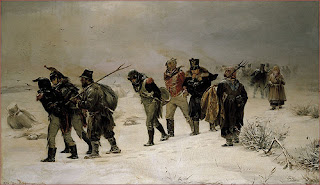Once again, Laurenist, one of the legendary
Panda Hat Twins, has drawn the ire of a well-intentioned albeit somewhat misguided celebrity; this time, George Clooney, a long-time activist for the Save Darfur movement.
Recently, the former "ER" star has advocated an "
anti-genocide paparazzi service", leasing satellite imagery services and enlisting the aid of an army of volunteers to monitor the border between northern and southern Sudan. In doing so, Clooney has joined the ranks of Network-Centric Warfare (NCW) fetishists, which have, mercifully, largely faded into obscurity following America's two wars in the Middle East, as well as the Israeli incursion into Lebanon.
Simply put, NCW advocates are characterized by a misplaced confidence in the abilities of Intelligence, Surveillance, and Reconaissance (ISR) assets to give commanders a better understanding of the situation on the ground. Such NCW champions include General Tommy Franks, who felt that satellite imagery, unmanned aerial vehicles, and networked computer systems would give commanders an "
Olympian view of the battlefield". Yet, despite this vast network of sensors, General Franks and his staff failed to "detect" a growing Sunni insurgency, which arose a few short weeks after the fall of Baghdad. This hubris extends even into the present day, when proponents of the military's new "Gorgon Stare" claim that the system, which incorporates multiple cameras attached to UAVs, allows commanders to "
see everything". Indeed, this sentiment also permeated the Israeli Defense Force in the years preceding the 2006 Lebanon War. Yet, Israeli paratroopers captured a video which depicted Hezbollah operatives slipping across the Israeli border, and casually pointing and mentioning an Israeli UAV orbiting nearby. Their speech implied that they had slipped across the border several times before, without being captured, despite extensive surveillance coverage. Even the US government, armed with the most sophisticated ISR sensors on the planet, has been hunting for a six-foot tall Arab and a one-eyed Pashtun in the FATA region of Pakistan for nearly ten years, with little to show for its efforts. Yet, George Clooney feels that he can do better with a group of volunteers, armed with low-resolution still-photo satellite imagery? Quite frankly, the idea is about as ill-conceived as, well, Bat-nipples.
 You won't catch Doctrine Man wearing bat-nipples. Though, let's face it, you won't catch Doctrine Man wearing much of anything these days.
You won't catch Doctrine Man wearing bat-nipples. Though, let's face it, you won't catch Doctrine Man wearing much of anything these days.
The problem with satellite imagery is, of course, that everyone believes they are an imagery analyst. After all, it's all there in the picture, right?
Well, not quite. To begin with, the satellites employed by Clooney and the "Enough Project" are of rather poor quality. Moreover, satellites only capture still photos, not video feeds, as one might see in a UAV or from other forms of aerial surveillance. Imagery also doesn't give the viewer a clear sense of
what or
whom they're really watching.
Although the conflict in Darfur is nominally being waged between ethnically Arab guerrillas and the Sudanese military, the latter of the which relies heavily on militia forces to do its work. Thus, the war is being fought between two largely irregular forces. Can you tell, from a satellite photo, the difference between a friendly militia and an enemy militia? Consider the case of the infamous "
Collateral Murder" video from last April, in which an Apache helicopter mistakenly gunned down two Reuters journalists. Though the pilots had high-quality full-motion video--leaps and bounds above what Clooney and his crew will have access to--they still mistook cameras with telephoto lenses, slung across their shoulders much like weapons, for rocket-propelled grenades. And though the armed figures in the video turned out to be insurgents, militias fighting on the side of the US, clad in civilian clothes, were not uncommon in Baghdad at the time of the video.
David Kilcullen notes, in
The Accidental Guerrilla, that despite nearly constant coverage from UAVs, surveillance blimps, and satellites, American planners could still not answer basic questions about the state of affairs in Iraq. The problem, of course, is that imagery is useless unless it's corroborated with substantial human intelligence. As Noah Shachtman of Wired Magazine
astutely notes, when fighting insurgencies, the best networks are social, not electronic.
The hunt for high-value insurgents in Iraq and Afghanistan certainly isn't accomplished with surveillance drones alone. After all, an insurgent's greatest strength is that he can blend in to the local population when needed. Yet, through a combination of, say, informants, captured documents, and surveillance, planners can gain a much clearer view into the true state of affairs in an insurgency. Using human intelligence to determine where to look and what to look for is far more effective than simply flying drones around in circles all day.
Which brings me to my point. I don't necessarily have an issue with a crowd-sourced satellite imagery campaign, per se. After all, Clooney and company are only spending their own money. However, we simply need to be realistic about its merits, and rightfully skeptical of any analysis which comes from grainy, still photos.
















